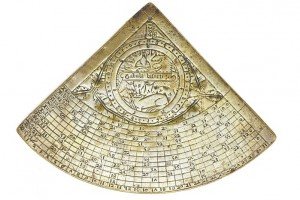A 14th century scientific instrument brought to New Zealand by a family emigrating from the north of England in the 1860s could fetch up to $NZ400,000 at auction in London next month.
The brass quadrant marked with the badge of King Richard II was brought to New Zealand in the 1860s by a family which emigrated from England, the ABC news reports.

When the last of the family died in New Zealand 60 years ago, the astrolabe was passed to relations on a Queensland cattle station, where, several decades later, Christopher Becker and his brother found it in a bag of pipe fittings.
The boys’ plaything is actually the second earliest dated British scientific instrument in existence — an equal hour horary quadrant with tables that gives the elevation angle of the sun at noon throughout the year — and dates from from 1396.
Now Mr Becker has put it up for sale and London-based auction house Bonhams has estimated that it will sell at between 150,000 and 200,000 pounds ($NZ300,000-$NZ400,000).
Mr Becker said the quadrant was sent to his family in a box with “all sorts of things” by a deceased line of relatives from New Zealand who took it with them when they emigrated from England.
But it was only at the start of this year that he found an online scientific journal, the Annals of Science, describing other similar quadrants which had some relationship to Richard II. The British Museum confirmed the quadrant’s significance. It is noteworthy for showing equal hours, in which the entire period from midnight to midnight is divided into 24 equal parts, a technique which developed slowly during the 14th century.
The horary quadrant was the most commonly used way of telling the time before the invention of the clock. During daylight, one edge of the quadrant was pointed directly at the sun, and a plumbline attached to the centre of the quadrant showed the hour of the day. One of the earliest examples in England of an administrative record using equal hours occurred on Richard II’s abdication on 30 September 1399, stated to have been ‘at about the ninth stroke of the clock’. On its reverse, the quadrant featured a badge depicting a stag lying down wearing a coronet around its throat, which is associated with Richard II. The earliest dated British scientific instrument in existence is the Chaucer astrolabe, dated 1326, housed in the British Museum.
Bonhams’ Australian operations chief James Hendy told the SMC:
“It’s one of only four known in the world. It dates from a particular period – in fact it’s dated 1396 so from the reign of Richard II – and it’s just very rare that these things come onto the market. It’s going to be keenly sought.”
“There are some very significant private collectors of early astrological instruments, who they themselves would certainly be very keen to own an item as rare as this. So I would imagine it will be fought for between an institution and a very serious private collector or collectors.”